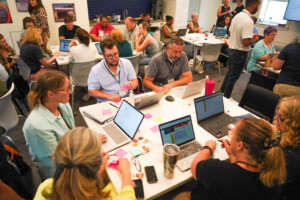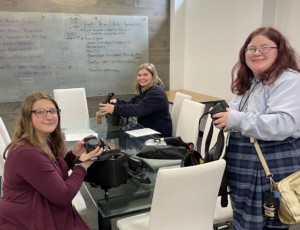Multiple Pathways to Competency-Based Education?

Competency-based learning is the most important meta trend of our time, not just in k-12, but in HigherEd, its complex shift because it address much of how we were taught to think about education. In The Shift from Cohorts to Competency, CompetencyWorks joined us in discussing multiple entry points for competency-based education (CBE) policies and practices. In this blog that first appeared on CompetencyWorks.org, Chris Sturgis shares multiple pathways to CBE.
Chris Sturgis
Last summer we published Implementing Competency Education in K-12 Systems: Insights from Local Leaders based on interviews with ten districts across the country. There were strong similarities about the major steps these districts used in converting their systems from time-based to success-based. What was interesting was that most of the districts had converted without a big investment of education technology or use of blended learning.
There are more and more districts interested in competency education, but they have different starting points. Many of them have already made the transition to blended learning and are more comfortable with students working on different units or skills. I’ve also visited one district, Eminence, which started with design thinking. (University of Kentucky dLAB, led by John Nash, is bringing design thinking into the schools in the Bluegrass State.) This has raised a bunch of questions for me about how these districts might find their way to competency education. Will they follow the same implementation process or will they forge a different way to a competency-based system? And if they do forge a different way, will this lead to different understandings of competency education and new designs? Or will these districts miss important steps and encounter new challenges?
Technical or Transformational?
A few people, all of whom I have the utmost respect for, have suggested that we need to document the different models of competency education in the same way we talk about the models of blended learning. I see the value of modelizing (Is that a word? If not, it should be. ), but I also see a huge risk in that it allows people to see competency education as a technical reform.
And we at CompetencyWorks don’t think it is.
Competency education is a paradigm shift – it is a change in the underlying assumptions. This means there has to be a way to shake off the old assumptions, which is tricky to do when all of us have grown up in the traditional education system. The goal of sorting students has to be replaced with nurturing success. Time isn’t a constraint but a resource. The fixed mindset has to be replaced with a growth mindset. A compliance culture has to be replaced with an empowered one. Hierarchical decision-making practices have to be replaced by inclusive ones with leaders using distributive leadership strategies. Educators are no longer teaching the curriculum; they are teaching children.
Thus, the transition process must include ways for people to embrace the new paradigm, get used to new practices that reinforce it, and strip away the old set of assumptions and values of the traditional system. I’ve seen one high school that did not invest in the transformative process and simply placed so-called competency-based practices on top of the traditional values. They got lost in a never-ending cycle of re-writing rubrics; students weren’t studying for time-based tests because they knew they could do a “re-do” (instead of taking on-demand assessments when ready); and the grading information system used an algorithm to translate scores into a GPA that no one seemed to be able to explain, so grading was more of a mystery than ever before. Teachers were exhausted and students were frustrated.
It is not clear to me which values and assumptions of the traditional system are challenged by online and blended learning. Certainly, there is a stronger focus on the growth mindset. However, as I understand it, most online schools and courses still focus on completion rather than mastery. Furthermore, I haven’t heard many blended districts talk about the importance of HOW students learn – helping students to build the Habits of Work they need to be empowered to own their learning. My biggest concern is that blended districts will understand competency education to be about flexible pacing rather than the deeper change of designing a system that generates success.
We need to get really clear about the degree to which blended learning is a technical reform and the ways it brings us closer to the new paradigm. Then, when districts are ready to take further steps toward competency education, they can create transition processes that take them further along the path to the new paradigm.
One more thing to think about – perhaps there are other values and assumptions that need to be put into place for a school to be blended? If so, districts that start with competency education will want to be ready to embrace the values that will lead to effective implementation of blended learning.
Creating an Empowered Culture Through Design?
Most of the districts I have visited talk about changing leadership and management styles so that decision-making is more inclusive, drawing on a range of perspectives and trying to maximize that decisions are made in the best interest of children as compared to the adult issues. They constantly return to their guiding beliefs to push for more creativity and move beyond traditional practices.
Distributed or adaptive leadership is important because student agency is a critical element of competency education. We want students to have the skills and the classroom to have the conditions for them to take ownership over their learning. Empowered students mean that teachers need to be empowered – to personalize learning, to make on-the-spot judgments, and to be able to work with their colleagues to respond to the changing needs and interests of students. An empowered workforce requires an empowering organization.
The human-centered design practices being used by districts is a different path to empowerment. Design means taking on an empowered position in which one can change one’s environment and the educational experiences for students. However, design without the new set of values, a shared vision or purpose, and the best research we have on how students learn may not get us to where we are going. Yes, we might organize a better learning experience through human-centered design, but if it is based on the values and beliefs of the traditional system, we might just be creating a better factory model.
Thus, when I think about how design thinking can be used to help districts move from traditional to blended to competency education, I think we need to expand to what I might call strategic design. By creating a set of principles to guide us, not unlike the guiding beliefs of competency-based districts, we would be more confident that every decision is taking us toward a system that can personalize education while still ensuring every student is benefiting.
We shouldn’t stop using human-centered design. It’s a fantastic process for helping educators develop a more student-centered orientation and for opening up our minds to think beyond all the traditional practices and rituals we grew up with. We just need to help prepare leadership and their teams to build the skills for a design process that will help them transform their organization as well as services.
Stumbling Blocks From Blended to Competency-Based?
In addition to the transformational process of creating a new set of operating values, competency-based education has a number of design and technical issues that need to be figured out regarding the instruction and assessment system (especially since the information management system vendors still don’t understand our needs). When districts begin to make decisions about how they are going to blend their instruction, they are making lots and lots of decisions about instruction and assessment.
To date, districts have approached these big changes – blended and competency education – sequentially. Perhaps one day we can create integrated approach. However, my guess is that it will be sequential for a while, as both require a lot of experiential learning. Schools get better at blended and operating a CBE system over time.
However, there might be a way to make it easier to move from one to the other.
What if we identified all the design decisions (and the new capacities that are required) upfront so schools could understand the future implications of their decisions? (See the third section of the paper on implementation for a list of these types of design decisions.)
For example, as a district becomes blended, they could take a look at the design decisions regarding instruction and assessment in a competency-based model and perhaps make some of those decisions early on. An easy one is selecting a knowledge taxonomy: Webb’s, Bloom’s, Marzano’s, or Hess’ cognitive rigor matrix. It’s an easy decision that leads to big changes. By using common language about depth of knowledge early on, teachers could be considering the value of adaptive software, ensuring that students have opportunities to learn and be assessed at higher levels than recall and comprehension, and be building up their capacity for performance-based assessments.
A Concluding Reflection
In a phone call with Susan Patrick, President of iNACOL and co-founder of CompetencyWorks, she raised the point that all of us will usually pick the path of least resistance. As we think about pathways toward a personalized system that is competency-based, highly flexible, and takes advantage of technology to support instruction and assessment, we need to ask ourselves what the most effective pathways are going to be. Technical is easier because when it doesn’t work exactly as how we imagined, we can blame the model rather than hold ourselves accountable. Transformation is more difficult because we all are operating outside of our comfort zone.
We have to ask ourselves, even if there are easier paths, are they really going to be good for our kids?
For more, check out:






0 Comments
Leave a Comment
Your email address will not be published. All fields are required.